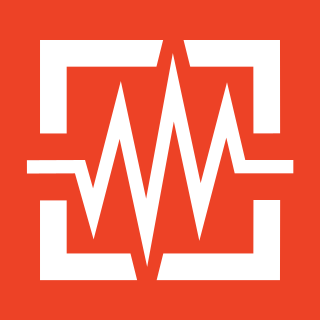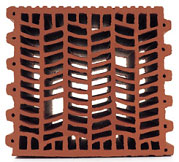Limit State Design (LSD), also known as Load And Resistance Factor Design (LRFD), refers to a design method used in structural engineering. A limit state is a condition of a structure beyond which it no longer fulfills the relevant design criteria. The condition may refer to a degree of loading or other actions on the structure, while the criteria refer to structural integrity, fitness for use, durability or other design requirements. A structure designed by LSD is proportioned to sustain all actions likely to occur during its design life, and to remain fit for use, with an appropriate level of reliability for each limit state. Building codes based on LSD implicitly define the appropriate levels of reliability by their prescriptions.
A structural load or structural action is a force, deformation, or acceleration applied to structural elements. A load causes stress, deformation, and displacement in a structure. Structural analysis, a discipline in engineering, analyzes the effects of loads on structures and structural elements. Excess load may cause structural failure, so this should be considered and controlled during the design of a structure. Particular mechanical structures—such as aircraft, satellites, rockets, space stations, ships, and submarines—are subject to their own particular structural loads and actions. Engineers often evaluate structural loads based upon published regulations, contracts, or specifications. Accepted technical standards are used for acceptance testing and inspection.

Cold-formed steel (CFS) is the common term for steel products shaped by cold-working processes carried out near room temperature, such as rolling, pressing, stamping, bending, etc. Stock bars and sheets of cold-rolled steel (CRS) are commonly used in all areas of manufacturing. The terms are opposed to hot-formed steel and hot-rolled steel.
BS 5400 was a British Standard code of practice for the design and construction of steel, concrete and composite bridges. It was applicable to highway, railway and pedestrian bridges. It has now been replaced by the European standard, BS EN 1991-2_2003 and other Eurocodes for the design of steel and concrete structures.

In the Eurocode series of European standards (EN) related to construction, Eurocode 2: Design of concrete structures specifies technical rules for the design of concrete, reinforced concrete and prestressed concrete structures, using the limit state design philosophy. It was approved by the European Committee for Standardization (CEN) on 16 April 2004 to enable designers across Europe to practice in any country that adopts the code.

In the Eurocode series of European standards (EN) related to construction, Eurocode 3: Design of steel structures describes how to design steel structures, using the limit state design philosophy.

In the Eurocode series of European standards (EN) related to construction, Eurocode: Basis of structural design establishes the basis that sets out the way to use Eurocodes for structural design. Eurocode 0 establishes Principles and requirements for the safety, serviceability and durability of structures, describes the basis for their design and verification and gives guidelines for related aspects of structural reliability. Eurocode 0 is intended to be used in conjunction with EN 1991 to EN 1999 for the structural design of buildings and civil engineering works, including geotechnical aspects, structural fire design, situations involving earthquakes, execution and temporary structures.

In the Eurocode series of European standards (EN) related to construction, Eurocode 7: Geotechnical design describes how to design geotechnical structures, using the limit state design philosophy. It is published in two parts; "General rules" and "Ground investigation and testing". It was approved by the European Committee for Standardization (CEN) on 12 June 2006. Like other Eurocodes, it became mandatory in member states in March 2010.

In the Eurocode series of European standards (EN) related to construction, Eurocode 1: Actions on structures describes how to design load-bearing structures. It includes characteristic values for various types of loads and densities for all materials which are likely to be used in construction.

In the Eurocode series of European standards (EN) related to construction, Eurocode 4: Design of composite steel and concrete structures describes how to design of composite structures, using the limit state design philosophy. It was approved by the European Committee for Standardization (CEN) on 4 November 2004. Eurocode 4 is divided in two parts EN 1994-1 and EN 1994-2.

In the Eurocode series of European standards (EN) related to construction, Eurocode 8: Design of structures for earthquake resistance describes how to design structures in seismic zone, using the limit state design philosophy. It was approved by the European Committee for Standardization (CEN) on 23 April 2004. Its purpose is to ensure that in the event of earthquakes:
EN 10025 - Hot rolled products of structural steels refers to a set of European standards which specify the technical delivery conditions for hot rolled products of structural steels. The standards consist of the following parts:

In the Eurocode series of European standards (EN) related to construction, Eurocode 9: Design of aluminium structures describes how to design aluminium alloy structures. It complies with the principles and requirements for the safety and serviceability of structures, the basis of their design and verification that are given in EN 1990 – Basis of structural design. It sets requirements for structural integrity, including strength, serviceability, durability and fire resistance.

In the Eurocode series of European standards (EN) related to construction, Eurocode 5: Design of timber structures describes how to design buildings and civil engineering works in timber, using the limit state design philosophy. It was approved by the European Committee for Standardization (CEN) on 16 April 2004. It applies for civil engineering works from solid timber, sawn, planned or in pole form, glued laminated timber or wood-based structural products, or wood-based panels jointed together with adhesives or mechanical fasteners and is divided into the following parts.

In the Eurocode series of European standards (EN) related to construction, Eurocode 6: Design of masonry structures describes how to design buildings and civil engineering works, or parts thereof, in unreinforced, reinforced, prestressed and confined masonry, using the limit state design philosophy. It was approved by the European Committee for Standardization (CEN) on 23 June 2005.
Robustness is the ability of a structure to withstand events like fire, explosions, impact or the consequences of human error, without being damaged to an extent disproportionate to the original cause – as defined in EN 1991-1-7 of the Accidental Actions Eurocode.
Metal profile sheet systems are used to build cost efficient and reliable envelopes of mostly commercial buildings. They have evolved from the single skin metal cladding often associated with agricultural buildings to multi-layer systems for industrial and leisure application. As with most construction components, the ability of the cladding to satisfy its functional requirements is dependent on its correct specification and installation. Also important is its interaction with other elements of the building envelope and structure. Metal profile sheets are metal structural members that due to the fact they can have different profiles, with different heights and different thickness, engineers and architects can use them for a variety of buildings, from a simple industrial building to a high demand design building. Trapezoidal profiles are large metal structural members, which, thanks to the profiling and thickness, retain their high load bearing capability. They have been developed from the corrugated profile. The profile programme offered by specific manufacturers covers a total of approximately 60 profile shapes with different heights. Cassettes are components that are mainly used as the inner shell in dual-shell wall constructions. They are mainly used in walls today, even though they were originally designed for use in roofs.
Luís Alberto Proença Simões da Silva also known as Luis Simoes da Silva, is a Professor of Structural Mechanics at the Department of Civil Engineering of the Faculty of Science and Technology at the University of Coimbra in Portugal. He is head of the Civil Engineering Department and director of Institute for Sustainability and Innovation in Structural Engineering research centre financed by FCT evaluated in 2014 with excellent. He is also president of cmm.

The infill wall is the supported wall that closes the perimeter of a building constructed with a three-dimensional framework structure. Therefore, the structural frame ensures the bearing function, whereas the infill wall serves to separate inner and outer space, filling up the boxes of the outer frames. The infill wall has the unique static function to bear its own weight. The infill wall is an external vertical opaque type of closure. With respect to other categories of wall, the infill wall differs from the partition that serves to separate two interior spaces, yet also non-load bearing, and from the load bearing wall. The latter performs the same functions of the infill wall, hygro-thermically and acoustically, but performs static functions too.






















